般现在时与现在进行时讲解及练习
- 格式:doc
- 大小:47.00 KB
- 文档页数:14
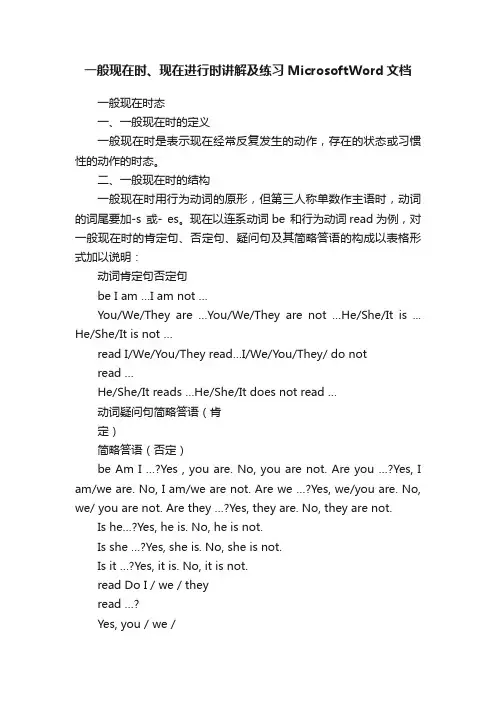
一般现在时、现在进行时讲解及练习MicrosoftWord文档一般现在时态一、一般现在时的定义一般现在时是表示现在经常反复发生的动作,存在的状态或习惯性的动作的时态。
二、一般现在时的结构一般现在时用行为动词的原形,但第三人称单数作主语时,动词的词尾要加-s 或- es。
现在以连系动词be 和行为动词read为例,对一般现在时的肯定句、否定句、疑问句及其简略答语的构成以表格形式加以说明:动词肯定句否定句be I am …I am not …You/We/They are …You/We/They are not …He/She/It is ... He/She/It is not …read I/We/You/They read…I/We/You/They/ do notread …He/She/It reads …He/She/It does not read …动词疑问句简略答语(肯定)简略答语(否定)be Am I …?Yes , you are. No, you are not. Are you …?Yes, I am/we are. No, I am/we are not. Are we …?Yes, we/you are. No, we/ you are not. Are they …?Yes, they are. No, they are not.Is he…?Yes, he is. No, he is not.Is she …?Yes, she is. No, she is not.Is it …?Yes, it is. No, it is not.read Do I / we / theyread …?Yes, you / we /they do.No, you / we / theydo not.Does he / she / itread … ?Yes, he / she / itdoes.No, he / she / it doesnot.连系动词be 的各种形式常与代词或not缩写成一个词。

一般现在时和现在进行时是初一阶段所学的两种重要时态,它们的不同之处有以下几点:1)基本用不同;2)谓语动词的形式不同;3)时间状语不同;4)有不同的特殊用法。
一、基本用法不同【1】一般现在时用来表示习惯性的动作或状态。
如:She goes to school by bike every day.她每天骑自行车去上学。
【2】现在进行时用来表示现在(说话的瞬间)正在发生或进行的动作或者用来表示现阶段正在进行或存在的状态。
如:Look ! She is reading under the tree.瞧!她正在树下看书。
二、谓语动词的形式不同【1】一般现在时的谓语动词:1) be动词用am/is/are这三种形式;2)实义动词用动词原形或第三人称单数形式(根据主语数的变化而变化)。
【2】现在进行时谓语动词的形式为:am / is / are+动词-ing 形式。
如:We go to school at seven in the morning.我们早晨七点钟上学。
I am reading English now. 我现在正在读英语。
三、时间状语不同【1】一般现在时常与often, sometimes, always, usually等频率副词及once a week/day等频率短语连用,还与every morning /day / week..., on Wednesday, in the morning / afternoon / evening等时间状语连用。
【2】现在进行时常与now, these days, these weeks等时间状语连用。
句首有Look ! / Listen !等提示语时,后面的句子中动词一般用现在进行时。
四、特殊用法1. 一般现在时的特殊用法:表示客观真理、自然现象往往要用一般现在时表示。
如:The moon goes round the earth.月亮绕着地球转。

一般现在时和现在进行时的区别及练习区别一般现在时现在进行时定义经常性和习惯性的动作(She gets up early every day.)或存在的状态(She is a teacher/beautiful.)说话时正在进行的动作或目前或现阶段正在进行的动作。
结构1.肯定句:主语+V原/V三单+其它They often drink tea. She often drinks tea.2.一般疑问句:Do/Does+主语+V原+其它Do they often drink tea? Does she often drink tea?3. 否定句:主语+don’t/doesn’t V原+其它They often don’t drink tea. She often drinks tea4.特殊疑问句:特殊疑问词+一般疑问句特殊疑问词+ do/does+主语+V原+其它?What do they often do? What does she often do?1.肯定句:主语+be V-ing+其它They are drinking tea. She is drinking tea.3.一般疑问句:Am/Is/Are+主语+V-ing +其它Are they drinking tea? Is she drinking tea?3. 否定句:主语+be not V原+其它They aren’t drinking tea. She isn’t drinking tea5.特殊疑问句:特殊疑问词+一般疑问句特殊疑问词+ be+主语+V-ing +其它?What are they doing? What is she doing?时间状语always, usually, often, sometimes, never,every day,on Sundays, in the morning/afternoon/eveningnow, at the/this moment,句首出现Look, Listen, It’s+时刻等特殊情况一、用所给词的正确形式填空1.The boy __________________ ( draw)a picture now.2. Listen ! Some girls _______________ ( sing)in the classroom .3. My mother _________________ ( cook )some nice food now.4. (1)What _____ you ______ ( do ) now?(2) What _____ you always______ ( do )?5. Look! They _______________( have) an English lesson .6.They ____________(not ,water) the flowers now.7.Look! the girls ________________(dance )in the classroom .8.A: What is our granddaughter doing? B: She _________(listen ) to music.9. It’s 5 o’clock no w. We _____________(have)supper.10.(1)______Henry____________(wash )clothes? Yes , he is .(2)______Henry____________(wash )clothes? Yes , he does .11. What ____he _____(mend) at the moment?12. Listen, who________(sing)in the next room?13. (1)We _____(play) games now. (2) We never_____(play) games. (3) He never_____(play) games.14. The girl____(like)wearing a sweater. Look! She ____(wear)a red sweater today.15. She_____ (go) to school from Monday to Friday.16. Liu Tao _____(do) not like PE.17. The child often______ (watch) TV in the evening.18. Su Hai ______(have) eight lessons this term.19. -What day ______(be) it today? -It’s Saturday.20. Don’t make a noise. Grandpa __________(sleep).21. Tom’s family__________(watch) TV every evening.22. It ________(take) me two hours to finish my homework every night.23. What ______ your mother _______(do) every evening? She _______(wash) clothes.24. _______ it ______ (rain)every day?25. What _______(do) you _______ on Sundays ? We ________ (play) football.26. There ________ (be) a football match on TV every morning.27. They often ________ (visit) the Great Wall.28. Who _______ (dance) the best in your class?29. He _____________ (not come).30. The earth __________ (move) round the sun.31 She ________ (buy) a sweater.32. Mr. Wang often______( go) to Shanghai.二、句型转换。
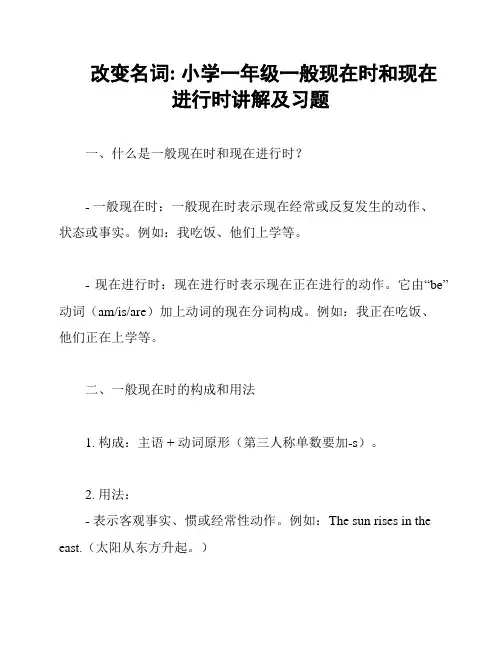
改变名词: 小学一年级一般现在时和现在进行时讲解及习题一、什么是一般现在时和现在进行时?- 一般现在时:一般现在时表示现在经常或反复发生的动作、状态或事实。
例如:我吃饭、他们上学等。
- 现在进行时:现在进行时表示现在正在进行的动作。
它由“be”动词(am/is/are)加上动词的现在分词构成。
例如:我正在吃饭、他们正在上学等。
二、一般现在时的构成和用法1. 构成:主语 + 动词原形(第三人称单数要加-s)。
2. 用法:- 表示客观事实、惯或经常性动作。
例如:The sun rises in the east.(太阳从东方升起。
)- 表示感觉、个人观点或常识。
例如:I like apples.(我喜欢苹果。
)三、现在进行时的构成和用法1. 构成:主语 + am/is/are + 现在分词。
2. 用法:- 表示现在正在进行的动作。
例如:I am eating dinner.(我正在吃晚饭。
)- 表示计划、安排或临时决定。
例如:We are going to the park.(我们要去公园。
)四、现在时和现在进行时的练题请根据句子的时间判断,将下面的动词填入一般现在时或现在进行时:1. My sister __________ (read) a book every day.2. They __________ (watch) TV at the moment.3. We __________ (go) to school from Monday to Friday.4. He ___________ (play) football every Saturday.5. I __________ (play) the piano right now.答案:1. reads2. are watching3. go4. plays5. am playing以上是关于小学一年级一般现在时和现在进行时的讲解及习题。
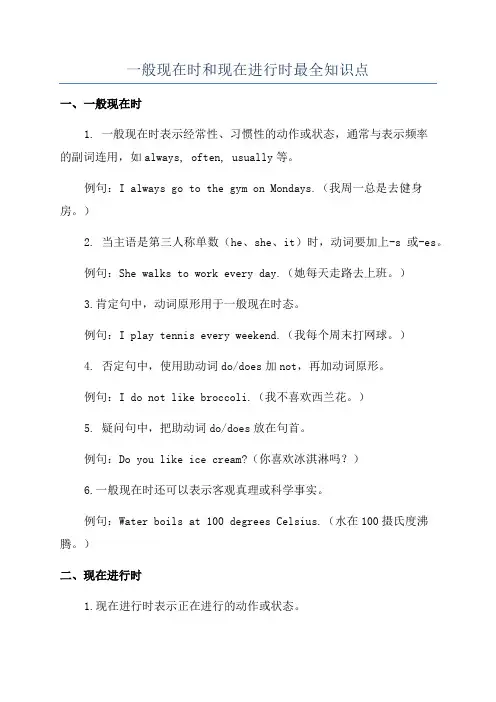
一般现在时和现在进行时最全知识点一、一般现在时1. 一般现在时表示经常性、习惯性的动作或状态,通常与表示频率的副词连用,如always, often, usually等。
例句:I always go to the gym on Mondays.(我周一总是去健身房。
)2. 当主语是第三人称单数(he、she、it)时,动词要加上-s或-es。
例句:She walks to work every day.(她每天走路去上班。
)3.肯定句中,动词原形用于一般现在时态。
例句:I play tennis every weekend.(我每个周末打网球。
)4. 否定句中,使用助动词do/does加not,再加动词原形。
例句:I do not like broccoli.(我不喜欢西兰花。
)5. 疑问句中,把助动词do/does放在句首。
例句:Do you like ice cream?(你喜欢冰淇淋吗?)6.一般现在时还可以表示客观真理或科学事实。
例句:Water boils at 100 degrees Celsius.(水在100摄氏度沸腾。
)二、现在进行时1.现在进行时表示正在进行的动作或状态。
例句:I am studying for my exams.(我正在备考。
)2. 现在进行时通常由be动词(am/is/are)和动词的现在分词形式(-ing形式)构成。
例句:He is reading a book.(他正在看书。
)3. 当主语是第三人称单数时,动词be要相应变成is。
例句:The dog is barking.(狗在叫。
4.现在进行时可以用来描述计划或安排将来要发生的事情。
例句:I am meeting my friends for lunch tomorrow.(我明天要和朋友们一起吃午饭。
)5. 否定句在be动词后加not。
例句:They are not watching TV.(他们不在看电视。
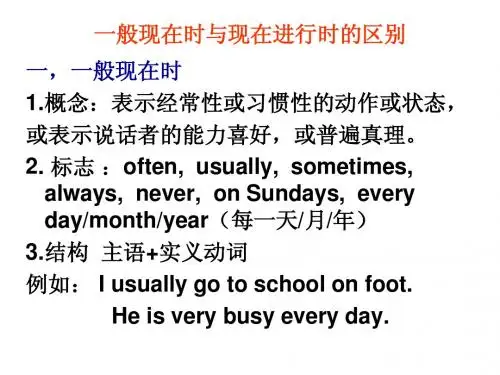
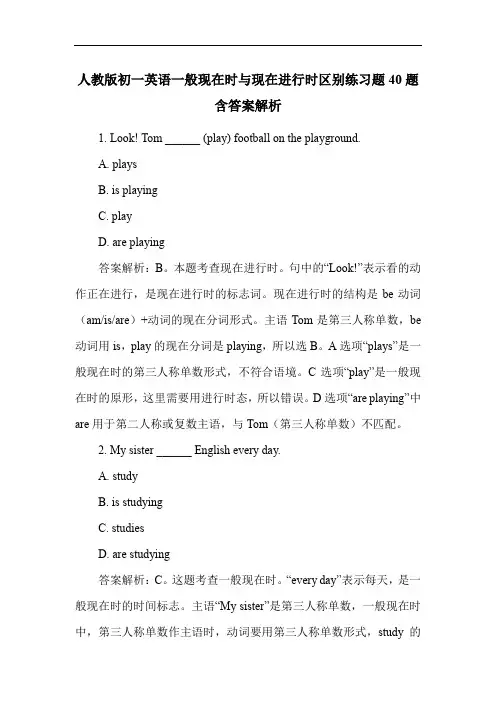
人教版初一英语一般现在时与现在进行时区别练习题40题含答案解析1. Look! Tom ______ (play) football on the playground.A. playsB. is playingC. playD. are playing答案解析:B。
本题考查现在进行时。
句中的“Look!”表示看的动作正在进行,是现在进行时的标志词。
现在进行时的结构是be动词(am/is/are)+动词的现在分词形式。
主语Tom是第三人称单数,be 动词用is,play的现在分词是playing,所以选B。
A选项“plays”是一般现在时的第三人称单数形式,不符合语境。
C选项“play”是一般现在时的原形,这里需要用进行时态,所以错误。
D选项“are playing”中are用于第二人称或复数主语,与Tom(第三人称单数)不匹配。
2. My sister ______ English every day.A. studyB. is studyingC. studiesD. are studying答案解析:C。
这题考查一般现在时。
“every day”表示每天,是一般现在时的时间标志。
主语“My sister”是第三人称单数,一般现在时中,第三人称单数作主语时,动词要用第三人称单数形式,study的第三人称单数形式是studies,所以选C。
A选项“study”是原形,用于第一、二人称或复数主语,不符合本题要求。
B选项“is studying”是现在进行时,与“every day”所表示的一般现在时的时间不符。
D选项“are studying”中are用于第二人称或复数主语,而本题主语是第三人称单数,所以错误。
3. Listen! The students ______ in the classroom.A. singB. are singingC. singsD. is singing答案解析:B。
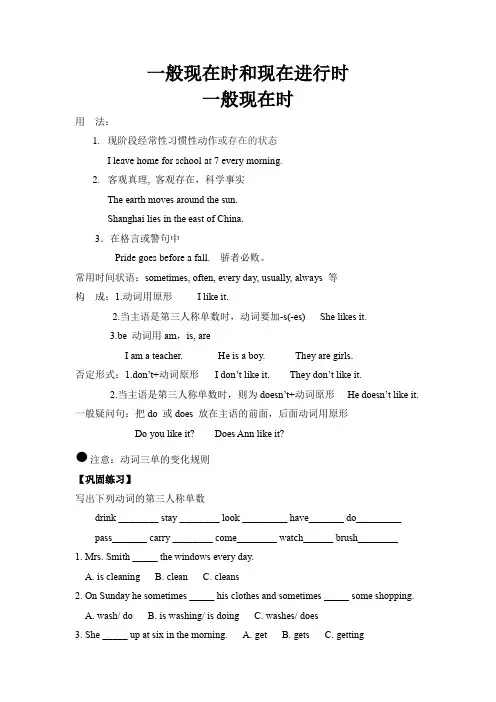
一般现在时和现在进行时一般现在时用法:1.现阶段经常性习惯性动作或存在的状态I leave home for school at 7 every morning.2.客观真理, 客观存在,科学事实The earth moves around the sun.Shanghai lies in the east of China.3.在格言或警句中Pride goes before a fall.骄者必败。
常用时间状语:sometimes, often, every day, usually, always 等构成:1.动词用原形I like it.2.当主语是第三人称单数时,动词要加-s(-es)She likes it.3.be 动词用am,is, areI am a teacher.He is a boy. They are girls.否定形式:1.don’t+动词原形I don’t like it.They don’t like it.2.当主语是第三人称单数时,则为doesn’t+动词原形He doesn’t like it.一般疑问句:把do 或does 放在主语的前面,后面动词用原形Do you like it? Does Ann like it?注意:动词三单的变化规则【巩固练习】写出下列动词的第三人称单数drink ________ stay ________ look _________ have_______ do_________pass_______ carry ________ come________ watch______ brush________1. Mrs. Smith _____ the windows every day.A. is cleaningB. cleanC. cleans2. On Sunday he sometimes _____ his clothes and sometimes _____ some shopping.A. wash/ doB. is washing/ is doingC. washes/ does3. She _____ up at six in the morning. A. get B. gets C. getting现在进行时1.定义:表示正在发生或进行的动作结构:be(am,is,are)+动词现在分词形式(简写:be+动词-ing)A、陈述句(肯定句)主语+be(am,is,are)+现在分词,如:I am reading English.我正在读英语。
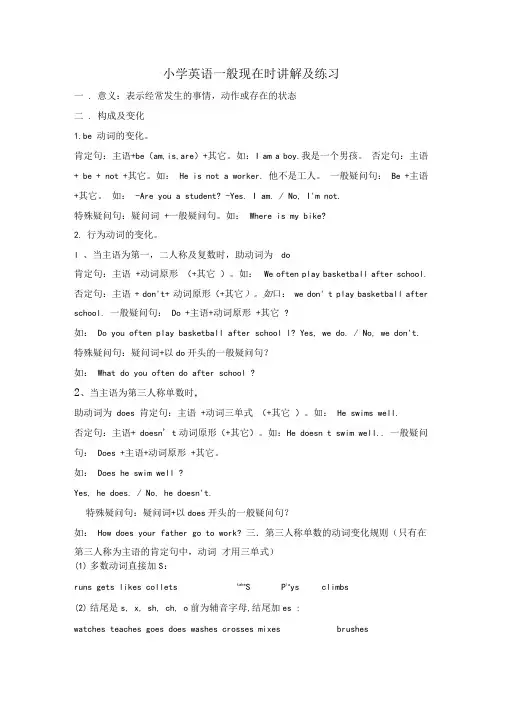
小学英语一般现在时讲解及练习一. 意义:表示经常发生的事情,动作或存在的状态二. 构成及变化1.be 动词的变化。
肯定句:主语+be(am,is,are)+其它。
如:I am a boy.我是一个男孩。
否定句:主语+ be + not +其它。
如:He is not a worker. 他不是工人。
一般疑问句:Be +主语+其它。
如:-Are you a student? -Yes. I am. / No, I'm not.特殊疑问句:疑问词+一般疑问句。
如:Where is my bike?2.行为动词的变化。
l 、当主语为第一,二人称及复数时,助动词为do肯定句:主语+动词原形(+其它)。
如:We often play basketball after school. 否定句:主语+ don't+ 动词原形(+其它)。
如口:we don' t play basketball after school. 一般疑问句:Do +主语+动词原形+其它?如:Do you often play basketball after school l? Yes, we do. / No, we don't. 特殊疑问句:疑问词+以do开头的一般疑问句?如:What do you often do after school ?2、当主语为第三人称单数时,助动词为does 肯定句:主语+动词三单式(+其它)。
如:He swims well.否定句:主语+ doesn' t动词原形(+其它)。
如:He doesn t swim well.. 一般疑问句:Does +主语+动词原形+其它。
如:Does he swim well ?Yes, he does. / No, he doesn't.特殊疑问句:疑问词+以does开头的一般疑问句?如:How does your father go to work? 三.第三人称单数的动词变化规则(只有在第三人称为主语的肯定句中,动词才用三单式)(1)多数动词直接加S:runs gets likes collets take S P la ys climbs(2)结尾是s, x, sh, ch, o前为辅音字母,结尾加es :brusheswatches teaches goes does washes crosses mixes(3)动词末尾y前为辅音:将y改为i加es: study —studies fly —flies carry —carries cry —cries但在y前如果为元音则直接加s: buys says四.时间标志:always , usually , ofte n , sometimes ,every一般现在时练习题(1)I.用下列单词的适当形式填空1.We often __________ (play) in the playgro und.2.He _________ (get) up at six o ' clock.3. _________ you ___________ (brush) your teeth every morning?4.What _________________ (do) he usually _________________ (do) after school?5.Da nny _________________ (study) En glish, Chin ese, maths, scie nee and Art atschool.6.Mike sometimes __________ (go) to the park with his sister.7.At eight at ni ght, she ______ (watch) TV with his pare nts.8. _______ Mike _________ (read) En glish every day?9.How many lessons __________ your classmates _________ (have) on Mon day?10.What time ________ his mother __________ (do) the housework?11.句型转换1.Do you often play football after school?(改为肯定句)2.1have many books.(改为否定句)3.Gao Shan ' s sister likes playingpble tennis (改为否定句)4.She lives in a small tow n near New York.(改为一般疑问句)5.1watch TV every day.(改为一般疑问句)6.We have four lessons.(改为否定句)7.Nancy doesn ' t run fast(改为肯定句)8.My dog runs fast.(改为否定句)9.Mike has two letters for him.一般疑问句:_________________________________________________ 否定句:___________________________________________________ 10.1usually play football on Friday after noon.否定句: ____________________________________________________ 一般疑问句:_______________________________________________ 划线提问:___________________________________________________ 11.Su Yang usually washes some clothes on Saturday.否定句: ____________________________________________________ 一般疑问句:_______________________________________________ 划线提问:_________________________________________________ 12.Mingming usually waters the flowers every day.否定句: ____________________________________________________ 一般疑问句:_______________________________________________ 13.Tom does his homework at home.否定句: ____________________________________________________ 一般疑问句:_______________________________________________ 一般现在时练习题(2)一、用所给动词的真确形式填空1.I like ____________ (swim).2. ___________ He (read) English every day.3. ___________ We (go)to school at seven in the morning.4. ___________ Mike (go)to school at seven in the morning.5. ________________ My mother ___ (like) (go) shopping.6.I can ________ (draw) many beautiful pictures.7.She __________ (make) a model plane.8.Do you _________ (like) ________ (run)?9.Does he ___________ (like) ______ (jump) ?10. __________________ Does Nancy (grow)flowers on Saturday ?11. __________________ The teachers _____ (like) (dance).12. __________________ The teacher ______ (like) (dance).13. _____________________ The students (speak) English in class.14. __________________ The student (speak) Chinese after class.15.Let ' s _____________ a nd play football . (go)16.He ______________ like swimming . (not)17.I ' m sorry _____________ that . (hear)18.Wang Bing is _____________ (write) an E-mail to his friend .19.He has ______________ a headache . (get)20. _______ you study English at school ? Yes , I _________ . (do)21. _________ your sister study English at school ? No , she _______ . (do)22.I ' m __________ better . (feel)23.Why ___________ Tom absent today ? (be)二、用所给的人称改写句子1.I take photos on Sunday. (Mike)2.We grow beautiful flowers. (she)3.They like collecting stamps. (Ben)4.I listen to music carefully. (my aunt)5.You like making a model ship. (Helen)6.We clean the classroom every day. (he)7.They look after the pandas. (Mr Wang)8.I draw a tree and some flowers. (Nancy) 9.We go to bed at eight. (my sister)10.I read newspapers in the evening. (Mr Green)小学现在进行时讲解及练习题1、概念:现在进行时表示说话时正在发生的事情或状态。
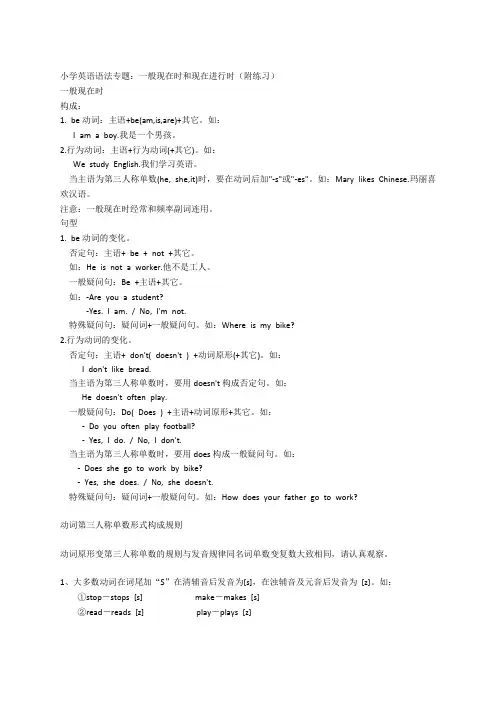
小学英语语法专题:一般现在时和现在进行时(附练习)一般现在时构成:1. be动词:主语+be(am,is,are)+其它。
如:I am a boy.我是一个男孩。
2.行为动词:主语+行为动词(+其它)。
如:We study English.我们学习英语。
当主语为第三人称单数(he, she,it)时,要在动词后加"-s"或"-es"。
如:Mary likes Chinese.玛丽喜欢汉语。
注意:一般现在时经常和频率副词连用。
句型1. be动词的变化。
否定句:主语+ be + not +其它。
如:He is not a worker.他不是工人。
一般疑问句:Be +主语+其它。
如:-Are you a student?-Yes. I am. / No, I'm not.特殊疑问句:疑问词+一般疑问句。
如:Where is my bike?2.行为动词的变化。
否定句:主语+ don't( doesn't ) +动词原形(+其它)。
如:I don't like bread.当主语为第三人称单数时,要用doesn't构成否定句。
如:He doesn't often play.一般疑问句:Do( Does ) +主语+动词原形+其它。
如:- Do you often play football?- Yes, I do. / No, I don't.当主语为第三人称单数时,要用does构成一般疑问句。
如:- Does she go to work by bike?- Yes, she does. / No, she doesn't.特殊疑问句:疑问词+一般疑问句。
如:How does your father go to work?动词第三人称单数形式构成规则动词原形变第三人称单数的规则与发音规律同名词单数变复数大致相同,请认真观察。
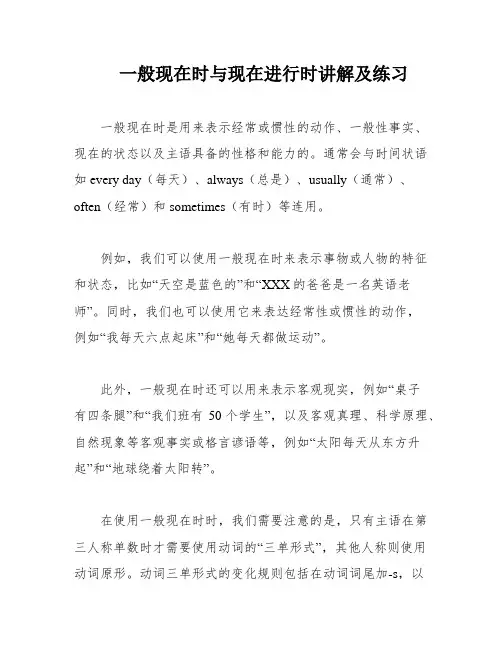
一般现在时与现在进行时讲解及练习一般现在时是用来表示经常或惯性的动作、一般性事实、现在的状态以及主语具备的性格和能力的。
通常会与时间状语如every day(每天)、always(总是)、usually(通常)、often(经常)和sometimes(有时)等连用。
例如,我们可以使用一般现在时来表示事物或人物的特征和状态,比如“天空是蓝色的”和“XXX的爸爸是一名英语老师”。
同时,我们也可以使用它来表达经常性或惯性的动作,例如“我每天六点起床”和“她每天都做运动”。
此外,一般现在时还可以用来表示客观现实,例如“桌子有四条腿”和“我们班有50个学生”,以及客观真理、科学原理、自然现象等客观事实或格言谚语等,例如“太阳每天从东方升起”和“地球绕着太阳转”。
在使用一般现在时时,我们需要注意的是,只有主语在第三人称单数时才需要使用动词的“三单形式”,其他人称则使用动词原形。
动词三单形式的变化规则包括在动词词尾加-s,以字母s、x、ch、sh或o结尾的动词在词尾直接加-es,以及以“辅音字母加-y”结尾的动词需要先变y为i再加-es。
此外,be和have是不规则变化的动词,分别变为is和has。
最后,我们可以通过一般现在时的句子转换来更好地理解和运用它。
例如,我们可以将肯定句转换为否定句,将否定句转换为肯定句,或者将陈述句转换为疑问句。
这些转换可以帮助我们更灵活地运用一般现在时,表达出更准确的意思。
When writing。
it is important to pay n to grammar rules。
One of the most common mistakes people make is XXX structure。
In order to avoid this。
it is XXX.To form a n。
if the sentence contains a form of the verb "to be" or a modal verb (such as can or could)。
一般现在时和现在进行时的区别一、概念不同:一般现在时表示主语经常性和习惯性的动作或存在的状态,也表示说话者的能力及自然现象。
而现在进行时表示说话时(瞬间)正在进行的动作,也表示目前或现阶段一直进行的动作。
如:She often does her homework in the evening.She is doing her homework now.二、在构成方式上的不同:一般现在时中谓语动词的构成有以下三种情况:①be 动词的一般现在时形式:am,is,are.②动词have 的一般现在时形式:have,has.③其他行为动词的一般现在时形式有动词原形或第三人称单数形式。
而现在进行时中谓语动词的构成是:am/is/are+动词的-ing 形式(现在分词)。
三、时间状语不同:一般现在时的时间状语主要有:always,usually,often,sometimes ,never ,every day ,on Sundays ,in the morning/afternoon/evening 等;现在进行时的时间状语主要有:now,these days,this week,at the moment 等,有时句首有“Look!”、“Listen!”或“It’s+时刻”等词、句存在。
如:We play football in the afternoon.(习惯性动作)My mother is reading a book now.(动作正在发生)四、用语范围不同:某种表示情感、意识(如want,like,know 等);表示“有” 的have 等动词,一般不用于现在进行时,但可用于一般现在时。
如:我现在就想回家。
误:I am wanting to go home now.正:I want to go home now.他有一台电脑。
误:He is having a computer.正:He has a computer.一.写出下列动词的第三人称形式和ing 形式。
.现在进行时A概念:表示正在发生的事情或动作,常和now,look,listen连用。
如:We are listening to music now.我们现在正在听音乐。
Listen! He is playing the piano. 听!他正在弹钢琴。
B、句子结构1.be + 动词现在分词(即:动词-ing形式),be + doing 是一个整体,不能分开。
2.be 随着主语的变化而变化,doing的变化规则根据现在分词的变化规律来定。
C、动词现在分词的构成规律1.一般情况下,在动词原形后直接加-ing;如:work→working do→doing play→playing2.以不发音字母e结尾的动词,先去掉e,再加-ing;如:dance→dancing come→coming3.在重读闭音节(即:辅音+元音+辅音)的动词中,要先双写末尾的辅音字母,再加-ing;如:get→getting shop→shopping run→running swim→swimming 4.以ie结尾的重读闭音节词,将ie改成y再加ing。
如:lie→lying die→dyingD、现在进行时的各种句式变化1.否定句方法:直接在be的后面加not。
如:They are running.→They are not running.2.一般疑问句方法:直接把be放在主语的前面,其余位置不变。
如:They are running.→Are they runnin?3.特殊疑问句方法:如果就划线部分提问事情或动作时,用What…doing?如:They are swimming in the sea now.→What are they doing in the sea now? 一般现在时态A 概念:表示经常性或习惯性的动作,常与表示频度的时间状语连用。
如:always, usually, often, sometimes, seldom(很少), never(决不), every day, at 8:30, on Sunday,in the morning等。
小学六年级上册英语时态精讲练习第一部分:一般现在时一般现在时表示现在的状态或惯性动作。
例子:1. I am a student. (我是一个学生。
)am a student. (我是一个学生。
)2. We play football every Sunday. (我们每个星期天都踢足球。
)play football every Sunday. (我们每个星期天都踢足球。
)练题:1. She often __(do)__ her homework at night. (她经常在晚上做作业。
)2. They __(be)__ my good friends. (他们是我好朋友。
)第二部分:现在进行时现在进行时表示现在正在进行的动作或状态。
例子:1. She is reading a book. (她正在看书。
)is reading a book. (她正在看书。
)2. I am doing my homework. (我正在做作业。
)am doing my homework. (我正在做作业。
)练题:1. They __ (play)__ football now.(他们现在正在踢足球。
)2. She __ (read)__ a book at the moment.(她现在正在看书。
)第三部分:一般过去时一般过去时表示过去发生的动作或状态。
例子:1. I was in Beijing last year. (我去年在北京。
)was in Beijing last year. (我去年在北京。
)2. We went to the park yesterday. (我们昨天去了公园。
)went to the park yesterday. (我们昨天去了公园。
)练题:1. He __ (be)__ at home last night.(他昨晚在家。
)2. They __ (go)__ to the cinema last weekend.(他们上周末去了电影院。
一般现在时一、定义与讲解:一般现在时表示经常或习惯性的动作或一般性事实..;也可表示现在的状态或主语具备的性格和能力..通常与副词every day每天;always总是;usually通常;often经常sometimes有时;等时间状语连用..例:1表示事物或人物的特征、状态..The sky is blue.天空是蓝色的..Mary’s father is an English teacher. 玛丽的爸爸是一名英语老师..2表示经常性或习惯性的动作..I get up at six every day.我每天六点起床..She plays sports every day. 她每天都做运动..3表示客观现实..The table has four legs.桌子有四条腿..There are 50 students in my class. 我们班有50个学生..4表示客观真理;科学原理;自然现象;等客观事实或格言谚语等..The sun rises in the east every day.太阳每天从东方升起..The earth goes around the sun.地球绕着太阳转..5表示平日的喜好..I like bananas. We don’t like vegetables.He likes ice cream. She doesn’t like strawberries.二.只有主语在第三人称单数时用动词的“三单形式”;其他人称用动词原形..★ 动词三单形式的变化规则:1.1多数直接在动词词尾加-s.play — plays like — likesask---asks work---works get---gets call---calls2以字母s; x; ch; sh或o结尾的动词;在词尾直接加-es.watch---watches wish---wishes do---does go---goes 3以“辅音字母加 - y”结尾的动词;要先变y为i再加-es.try---tries study---studies cry---cries fly---flies2.不规则变化:be---- is have----has三、一般现在时的句子转换:1变一般疑问句:当句子中有be动词或情态动词时;则把be动词或情态动词can;could等提到主语的前面;口诀:一调二变三问号;2变否定句:在be动词或情态动词后面直接加not变成否定句. be后not莫忘记例:①陈述句:She is my sister..疑问句→ Is she your sister Yes; I am./ No; I’m not.否定句→ She is not my s ister.②陈述句:I can play soccer.疑问句→ Can you play soccer Yes;Ican./ No; I can’t.否定句→ I can not /can’t play soccer.★注意:对一般疑问句的回答:一般用什么问就用什么来回答..但以下例外:Is this a pencil Yes ; it is./ No; it isn’t.Is that your backpack Yes ; it is./ No; it isn’t. Are these your parents Yes; they’re./ No; they aren’t.Are those Jim’s brothers Yes;they’re./ No; they aren’t. 3当句子中没有be动词;也没有情态动词时;变一般疑问句时;在主语前加助动词do I; we; you;以及复数; does第三人称单数she;he;it等变成问句;4变否定句时;在主语后谓语动词前加助动词don’t; doesn’t变成否定句;切记:助动词后的动词则还原成动词原形..例:①陈述句:We get up起床 at 7:00 every morning.疑问句→Do you get up at 7:00 every morning否定句→We don’t get up at 7:00 every morning.②陈述句:She has a brother.疑问句→ Does she have a brother否定句→ She doesn’t have a brother.※ 在一般现在时中;当主语是第三人称单数时;谓语动词要用第三人称单数形式;即常在动词原形后加-s或-es..但有些同学们对于哪些主语是第三人称单数还不十分清楚;现归纳总结如下:一、人称代词he; she; it是第三人称单数..如:He likes watching TV. 他喜欢看电视..She has lunch at twelve. 她十二点吃午餐..二、单个人名、地名或称呼作主语;是第三人称单数..如:①Han Mei likes salsd . 韩梅喜欢萨拉..②Beijing is in China. 北京在中国..③Uncle Wang often plays volleyball.. 王叔叔经常打排球..三、单数可数名词或"this / that / the+单数可数名词"作主语时;是第三人称单数..如:②This book is yours. 这本书是你的..③That car is red. ④The cat is Lucy's. 这只猫是露茜的..四、不定代词someone; somebody; nobody; everything; something等及指示代词this; that作主语时;是第三人称单数..①Everyone is here. 大家到齐了..②There is a watch on the table. 桌上有块手表..③This is a pen. 这是一支钢笔..④That is an eraser.五、不可数名词作主语时为第三人称单数..如:①The milk牛奶 is in the glass. 牛奶在玻璃杯里..②The bread is very small. 那面包很小..六、当数字或字母作主语时;看作第三人称单数..如:①"6" is a lucky number. "6"是个吉利数字..②"I" is a letter. "I"是个字母..一、按照要求改写句子1.This is my pencil 变一般疑问句 your pencil2. These red socks are Kate’s . 变一般疑问句socks Kate’s3. Mary does not have any books . 变肯定句 some books .4. She likes the black bag very much . 变为否定句5. I like apples. 用she改写句子6. It’s an English dictionary . 对画线部分提问.7. He has hamburger and apples for dinner . 变一般疑问句二、用Be动词填空..1. you Li Fen No; not .2. Mr. green very busy Yes ; he .3..This book very interesting .4. What class you in5. You and I good friends .6. The basketball club fun .三.用所给动词的适当形式填空..1. Lin Tao like his ruler .2. Let’s have ice cream .3. Let’s play tennis4. He like English.5. Nice meet you6. I need some fruits.一般现在时用法专练:一、写出下列动词的第三人称单数形式..have like drink _____ go _____ stay ____ study___ _ teach_____make ______look ______have____ come_____ watch______ plant_____ fly _____ do_____ 二、用括号内动词的适当形式填空..1. He often ________have dinner at home.2. Daniel and Tommy _______be in Class One.3. We_______not watch TV on Monday.4. Nick ____ ___not go to the zoo on Sunday.5. ______ they ________like pears6. _______ your parents _______have eggs every day7. There ________be some water in the bottle.18. Mike _______like cooking.9. They _______have the same hobby.10. Liu Tao ______ _do not like PE.11. This boy often _______watch TV in the evening.五、改错划出错误的地方;将正确的写在横线上1. Is your brother speak English __________________2. Does he likes going fishing ________________3. He likes play games after class. _______________ __4. Mr. Wu teachs us English. _______________5. She don’t do her homework on Sundays. _____________一般现在时态句型转换1.This is a white key. 对画线部分进行提问2.Ben’s bag is yellow and red . 对画线部分进行提问3.Her name is Gina. 对画线部分进行提问4.My phone number is 673-8220. 对画线部分进行提问5.The boy’s name is Jack. 对画线部分进行提问6.The picture is on the wall. 对画线部分进行提问7.Your baseball is under the chair. 对画线部分进行提问8.His book is on the desk. 对画线部分进行提问9.Some balls are in the dresser. 对画线部分进行提问10.My computer is on my desk. 对画线部分进行提问11.He is Johnny. 改为一般疑问句12.These are his parents. 改为一般疑问句13.This is my sister. 改为一般疑问句14.The baseball is under the bed. 改为一般疑问句15.My key is on the bed. 改为一般疑问句16.He has a tennis racket. 改为一般疑问句17.I have some baseball bats. 改为一般疑问句18.She has many things to do today. 改为一般疑问句19.I like hamburgers . 改为一般疑问句20.They have a TV. 改为一般疑问句25.You are Tina. 改为否定句26.These are my brothers. 改为否定句27.The books are on the bookcase. 改为否定句28.Three books are under the desk. 改为否定句29.She has a computer game. 改为否定句30.We have a big TV in our house. 改为否定句31.Kate has some money in her pocket. 改为否定句32.He likes ice cream. 改为否定句34.Nice to meet you 写出答语35.Is that a dictionary 改为复数句____________________________________________36These are photos. 改为单数句37.Is he your cousin 作肯定回答38.Is Linda his sister 作否定回答39.Is this a Chinese book 作否定回答40.Those are dictionaries. 改为单数句41.Is the CD on the sofa 作肯定回答42.Are the chairs next to the table 作否定回答43.Where is my book 改为复数句子44.They are on the sofa . 改为单数句子现在进行时现在进行时是由“助动词beam; is; are+动词-ing”构成;表示说话者“此刻”或现阶段的行为..二、现在进行时的基本结构1.肯定句:主语+beam; is; are+现在分词+…… 例如:I am speaking with him on the phone. 我正和他通电话..He is playing tennis. 他正在打网球.. My parents are dancing. 我父母正在跳舞..2.否定句:主语+be not+现在分词+…… 例如:I'm not studying. 我没在学习.. She is not reading now. 现在她不是在看书..They are not writing. 他们没在写..3.一般疑问句:Be动词+主语+现在分词+…… 例如:1— Is she still helping Li Ling她还在帮助李玲吗— Yes; she is. 是的../No; she isn't. 不;她没在帮李玲..2— Are you listening to music 你正在听音乐吗— Yes; I am. 是的../No; I'm not. 不;我没有听音乐..4.特殊疑问句:特殊疑问词+be动词+主语+现在分词+…… 例如:—What are you studying 你正在学什么—I'm studying English. 我在学英语..— What is Mike doing 迈克在做什么----He is watching the football match. 他在看足球比赛..三、现在分词的变化规则1.一般在动词末尾加ing;如: think-thinkinggo-going2.以不发音字母e结尾的动词;先去掉e;再加ing;如:come-coming make-making3.以重读闭音节结尾的动词;中间只有一个元音字母;词尾只有一个辅音字母;应双写末尾的辅音字母;再加ing; 如: put-puttingrun-running四、现在进行时的基本用法1.表示此时此刻说话者正在进行的动作..例如:The teacher is talking with his students. 这位老师正在同他的学生交谈..What are you doing now 你现在干什么呢2.表示现阶段正在进行的动作;但此刻并不一定在进行.. 例如:We are doing an experiment this week. 我们这个星期正在做一个实验..但说话时并不一定在做实验..3.现在进行时有时可用来表示将来发生的动作;这一用法常用于go; come; leave; start 等短暂性动词;后面也常用表示较近的将来时间状语如tomorrow; tonight; this morning/Friday等;表示安排或计划好的事情..例如:We are leaving for Shanghai tomorrow. 我们明天启程去上海..4.现在进行时表示说话时正发生的或者正进行的动作..常与时间状语 now ; at the moment 等连用..It is raining hard now . Don't hurry .I am writing a letter . Will you please turn down the radioWatch out 当心 It's falling .Look The clouds are gathering .Look at this picture of a busy railway station . A train is standing at one of the platforms ready to leave . Some of thepassengers are looking out of the windows watching thelate-comers who are hurrying along looking for empty seats .We are busy at the moment . I'm selling cigarettes . My father is selling some sweets .5.表示按计划、安排将要发生的动作..We are going to Rome next week . Mr Black is leaving for Shanghai in a few days .Are you doing anything special tonight6.用在时间和条件状语从句中表达将来正进行的动作..I'll telephone you tomorrow while I'm waiting .I'll think about it while you are writing the report .When you are talking with him ; take care not to mention this .If you are standing at the corner when I pass ; I'll give you a lift into town .五、现在进行时的练习题按要求改写句子The boy is playing basketball.否定句:____________________________ 一般疑问句:_________________________肯定回答:__________________________ 否定回答:__________________________对“is playing basketball”提问:__________________________对“ The boy”提问:__________________________They are singing in the classroom.否定句:____________________________ 一般疑问句:_________________________肯定回答:__________________________ 否定回答:__________________________对“are singing ”提问:__________________________对“ in the classroom”提问:__________________________4.she;the window ;open; now.用现在进行时连词成句._____________________5.The birds are singing in the tree.就划线部分提问________________________6.is;who;the window; cleaning 连词成句______________________7. The children are playing games near the house.就划线部分提问_______________8.She is closing the door now.改成否定句______________________9.You are doing your homework.用“I”作主语改写句子______________________10.they;the tree; sing; now; under.用现在进行时连词成句._____________________11.The Young Pioneers are helping the old woman.改成一般疑问句______________________II.单项选择1.我在照看孩子.AI am looking after the baby. BI'm look aftering the baby.CI look am aftering the baby. DI looking after the baby.2._____friend's making ______a kite.AI; me BMy; my CMy; me DHis; his3.Is the woman ______ yellow your teacherAin Bputting on CwearingDhaving4.LookThe twins _____their mother do the housework.Aare wanting Bhelp Care helping Dare looking5._____are the birds doing They are singing in a tree.AWho BWhat CHowDWhere6.Is she ____somethingAeat Beating Ceatting Deats7.你在干什么AWhat is you doing BWhat are you doCWhat are you doing DWhat do you do8.What are you listening_____A/ Bfor Cat Dto9.我正在听他说话.AI listening to him. BI'm listening to him.CI'm listen to him. DI'm listening him.10.They are ____their clothes.Amakeing Bputting Cput awayDputting onIII.用现在进行时完成下列句子:1.What_________you__________do2.I______________sing an English song.3.What__________he____________mend4.He______________menda car.5._________you__________fly a kite Yes ;_______.6._________she___________sit in the boat7._________you_____________ask questions8.We_______________play games now.9.The man______________work near the house now.。
一般现在时一、定义与讲解:一般现在时表示经常或习惯性的动作或一般性事实。
,也可表示现在的状态或主语具备的性格和能力。
通常与副词every day(每天),always(总是),usually(通常),often(经常)sometimes (有时),等时间状语连用。
例:(1)表示事物或人物的特征、状态。
The sky is blue.天空是蓝色的。
Mary’s father is an English teacher. 玛丽的爸爸是一名英语老师。
(2)表示经常性或习惯性的动作。
I get up at six every day.我每天六点起床。
She plays sports every day. 她每天都做运动。
(3)表示客观现实。
The table has four legs.桌子有四条腿。
There are 50 students in my class. 我们班有50个学生。
(4)表示客观真理,科学原理,自然现象,等客观事实或格言谚语等。
The sun rises in the east every day.太阳每天从东方升起。
The earth goes around the sun.地球绕着太阳转。
(5)表示平日的喜好。
I like bananas. We don’t like vegetables.He likes ice cream. She doesn’t like strawberries.二.只有主语在第三人称单数时用动词的“三单形式”,其他人称用动词原形。
★ 动词三单形式的变化规则:1.(1)多数直接在动词词尾加-s.play — plays like — likesask---asks work---works get---gets call---calls(2)以字母s, x, ch, sh或o结尾的动词,在词尾直接加-es.watch---watches wish---wishes do---does go---goes(3)以“辅音字母加 - y”结尾的动词,要先变y为i再加-es.try---tries study---studies cry---cries fly---flies2.不规则变化:be---- is have----has三、一般现在时的句子转换:(1)变一般疑问句:当句子中有be动词或情态动词时,则把be动词或情态动词(can,could 等)提到主语的前面,(口诀:一调二变三问号);(2)变否定句:在be动词或情态动词后面直接加not变成否定句. (be后not莫忘记)例:①陈述句:She is my sister..疑问句→ Is she your sister Yes, I am./ No, I’m not.否定句→ She is not my sister.②陈述句:I can play soccer.疑问句→ Can you play soccer Yes,Ican./ No, I can’t.否定句→ I can not /can’t play soccer.★注意:对一般疑问句的回答:一般用什么问就用什么来回答。
但以下例外:Is this a pencil Yes , it is./ No, it isn’t.Is that your backpack Yes , it is./ No, it isn’t.Are these your parents Yes, they’re./ No, they aren’t.Are those Jim’s brothers Yes,they’re./ No, they aren’t.(3)当句子中没有be动词,也没有情态动词时,变一般疑问句时,在主语前加助动词do (I, we, you,以及复数), does(第三人称单数she,he,it等)变成问句;(4)变否定句时,在主语后谓语动词前加助动词don’t, doesn’t变成否定句,切记:助动词后的动词则还原成动词原形。
例:①陈述句:We get up(起床) at 7:00 every morning.疑问句→Do you get up at 7:00 every morning否定句→We don’t get up at 7:00 every morning.②陈述句:She has a brother.疑问句→ Does she have a brother否定句→ She doesn’t have a brother.※ 在一般现在时中,当主语是第三人称单数时,谓语动词要用第三人称单数形式,即常在动词原形后加-s或-es。
但有些同学们对于哪些主语是第三人称单数还不十分清楚,现归纳总结如下:一、人称代词he, she, it是第三人称单数。
如:He likes watching TV. 他喜欢看电视。
She has lunch at twelve. 她十二点吃午餐。
二、单个人名、地名或称呼作主语;是第三人称单数。
如:①Han Mei likes salsd . 韩梅喜欢萨拉。
②Beijing is in China. 北京在中国。
③Uncle Wang often plays volleyball.. 王叔叔经常打排球。
三、单数可数名词或"this / that / the+单数可数名词"作主语时,是第三人称单数。
如:②This book is yours. 这本书是你的。
③That car is red. ④The cat is Lucy's. 这只猫是露茜的。
四、不定代词someone, somebody, nobody, everything, something等及指示代词this, that作主语时,是第三人称单数。
①Ev eryone is here. 大家到齐了。
②There is a watch on the table. 桌上有块手表。
③This is a pen. 这是一支钢笔。
④That is an eraser.五、不可数名词作主语时为第三人称单数。
如:①The milk(牛奶) is in the glass. 牛奶在玻璃杯里。
②The bread is very small. 那面包很小。
六、当数字或字母作主语时,看作第三人称单数。
如:①"6" is a lucky number. "6"是个吉利数字。
②"I" is a letter. "I"是个字母。
一、按照要求改写句子1.This is my pencil (变一般疑问句) your pencil2. These red socks are Kate’s . (变一般疑问句)socks Kate’s3. Mary does not have any books . (变肯定句) some books .4. She likes the black bag very much . (变为否定句)5. I like apples. (用she改写句子)6. It’s an English dictionary . (对画线部分提问).7. He has hamburger and apples for dinner . (变一般疑问句)二、用Be动词填空。
1. you Li Fen No, not .2. Mr. green very busy Yes , he .3..This book very interesting .4. What class you in5. You and I good friends .6. The basketball club fun .三.用所给动词的适当形式填空。
1. Lin Tao (like) his ruler .2. Let’s (have) ice cream .3. Let’s (play) tennis !4. He (like) English.5. Nice (meet) you !6. I (need) some fruits.一般现在时用法专练:一、写出下列动词的第三人称单数形式。
have like drink _____ go _____ stay ____ study___ _ teach_____make ______look ______have____ come_____ watch______ plant_____ fly _____ do_____二、用括号内动词的适当形式填空。
1. He often ________(have) dinner at home.2. Daniel and Tommy _______(be) in Class One.3. We_______(not watch) TV on Monday.4. Nick ____ ___(not go) to the zoo on Sunday.5. ______ they ________(like) pears6. _______ your parents _______(have) eggs every day7. There ________(be) some water in the bottle.18. Mike _______(like) cooking.9. They _______(have) the same hobby.10. Liu Tao ______ _(do) not like PE.11. This boy often _______(watch) TV in the evening.五、改错(划出错误的地方,将正确的写在横线上)1. Is your brother speak English __________________2. Does he likes going fishing ________________3. He likes play games after class. _______________ __4. Mr. Wu teachs us English. _______________5. She don’t do her homework on Sundays. _____________一般现在时态句型转换1.This is a white key. (对画线部分进行提问)2.Ben’s bag is yellow and red . (对画线部分进行提问)3.Her name is Gina. (对画线部分进行提问)4.My phone number is 673-8220. (对画线部分进行提问)5.The boy’s name is Jack. (对画线部分进行提问)6.The picture is on the wall. (对画线部分进行提问)7.Your baseball is under the chair. (对画线部分进行提问)8.His book is on the desk. (对画线部分进行提问)9.Some balls are in the dresser. (对画线部分进行提问)10.My computer is on my desk. (对画线部分进行提问)11.He is Johnny. (改为一般疑问句)12.These are his parents. (改为一般疑问句)13.This is my sister. (改为一般疑问句)baseball is under the bed. (改为一般疑问句)key is on the bed. (改为一般疑问句)has a tennis racket. (改为一般疑问句)have some baseball bats. (改为一般疑问句)has many things to do today. (改为一般疑问句)like hamburgers . (改为一般疑问句)have a TV. (改为一般疑问句)are Tina. (改为否定句)are my brothers. (改为否定句)books are on the bookcase. (改为否定句)books are under the desk. (改为否定句)has a computer game. (改为否定句)have a big TV in our house. (改为否定句)has some money in her pocket. (改为否定句)likes ice cream. (改为否定句)to meet you! (写出答语)35.Is that a dictionary (改为复数句)____________________________________________ 36These are photos. (改为单数句)he your cousin (作肯定回答)Linda his sister (作否定回答)this a Chinese book (作否定回答)are dictionaries. (改为单数句)the CD on the sofa( 作肯定回答)the chairs next to the table (作否定回答)is my book (改为复数句子)are on the sofa .( 改为单数句子)现在进行时现在进行时是由“助动词be(am, is, are)+动词-ing”构成,表示说话者“此刻”或现阶段的行为。